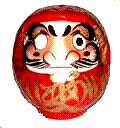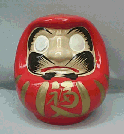![]()
DARUMA
Daruma is one of the best-known folk toys in Japan and can always be seen at temple festivals. When an election campaign starts, a daruma doll is displayed on a Shinto-altar in campaign offices as a good luck charm for politicians who would like to win an election.
What is daruma? Daruma is said to
portray an ancient Chinese Zen master named Bodai Daruma. He was
born a prince in Southern India around the fifth century and grew
up to become a priest . It is also well known that he sat
cross-legged in meditation for nine years without moving. As a
result, his limbs were numbed and he became unable to walk. 
Using a daruma doll as a good-luck charm is said to have originated at Syorinji temple in Takasaki City in Gunma Prefecture. In 1783, when the great famine hit the area, the priest of the temple made wooden models of a painting of Bodai Daruma and helped poor farmers there make dolls. The dolls have become very popular and are known throughout Japan. The red daruma doll has been used as a good luck charm to keep people from disease since red is the color believed to get rid of evil. Furthermore, the daruma doll has weight added to its bottom so that it always bobs back up whenever it is knocked over. Because of that, it is often used as a mascot to bring good luck to merchants and politicians who hope for success in spite of difficulties.
Most of the daruma dolls sold as good-luck charms have no eyes. That is because there is a pun on the sound gan,which can mean either ‘wish’ or ‘eye’depending on the character used to write it. Usually, when wishing for something, you paint in the left eye of a daruma doll. When your wish is fulfilled, you paint his right eye to celebrate. Then, you take it to the local shrine as an offering, burn it in a bonfire at New Year's, or float it in the river. Why don't you buy a daruma doll and make a wish?
【Reference】Japan from A to Z, Yen Books
